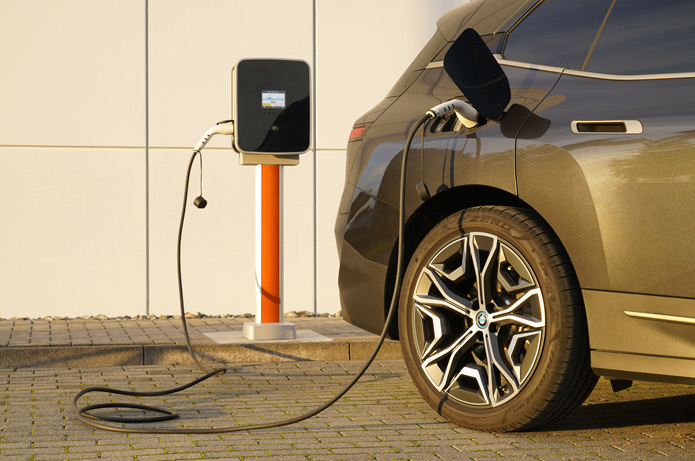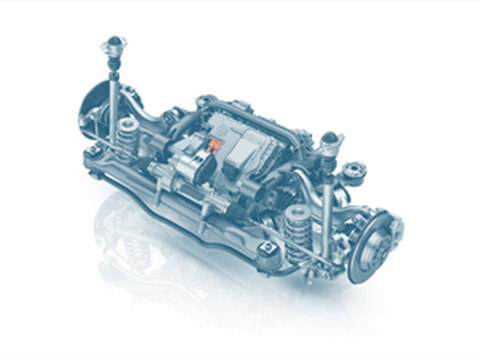Electric car charging station
Electric car charging stations are an important aspect of modern mobility. They allow electric vehicle owners to charge their vehicles. To do this, the electric vehicle must be connected to a charging point or a wallbox that is connected to a power source.
Function
Electric car charging stations are specially designed facilities that allow electric vehicle owners to charge their vehicles. Most charging stations use alternating current (AC), which is available in most homes and businesses, to charge electric vehicle batteries. That said, DC charging stations, which use direct current to speed up the battery charging process, are also available.
An electric car is usually charged via a charging point that is connected to a power source. There are also wall charging stations, known as wallboxes, which are usually installed on private property, for example on a garage wall.
Charging options
Using a mains socket
A household mains socket is the easiest way to charge an electric car. In this case, the car is connected to a normal protective-earth socket with a “mode 2” charging cable. It is not possible to use, for example, a “mode 3” charging cable, which is only suitable for charging at BEV charging stations. However, this type of charging is relatively slow and there can be issues with overloading the power grid, plus the charging loss is very high.
Using a wallbox
A wallbox is a faster option that has been specially developed for charging electric cars. The wallbox is usually installed by an electrician and is connected directly to the electrical grid. It has a higher charging capacity and is safer than household sockets.
Using a public charging station
Public charging points are usually found in the city or next to motorways. They enable drivers to charge their electric cars quickly and reliably and are equipped with different types of connectors. With fast charging stations, it is possible to charge electric cars very quickly. A charging card or an app is used to gain access.
Charging modes
The international standard IEC 62196 sets out a range of charging modes, charging cables and connector types:
Mode 1: Charging with alternating current (AC) at household sockets with protective-earth contacts using a maximum of 16 A. A mode 1 charging cable is a basic cable that does not provide electrical protection. Therefore, charging with a mode 1 charging cable is dangerous! For this reason, it is banned in many countries.
Mode 2: Charging with alternating current at household sockets with protective-earth contacts using a maximum of 16 A, single-phase or three-phase using a maximum of 32 A. Charging is carried out using a charging cable that has a control and protective function device integrated into the cable.
Mode 3: Fast charging with alternating current at (public) charging stations up to 250 A. Simple connectors with class 2 pilot contact can be used, but these limit the charging current to 32 A.
Mode 4: Fast charging with direct current (DC) up to 400 A, with the charger permanently integrated into the charging station and the charging cable is tethered to the charging station.
Connector
To make use of the different charging modes, it is necessary to determine which connectors are to be used at the corresponding locations.
A distinction is made between two types of connections:
- A “power-side” connection between the socket and the charging cable or between the charging station and the charging cable
- A connection between the charging cable and the vehicle
The IEC 62196 standard governs the use of connectors according to the charging mode. The standard defines three connection types:
- Connection type IEC 62196-2 type 1: “single phase vehicle coupler”
- Connection type IEC 62196-2 type 2: “single and three phase vehicle coupler”
- Connection type IEC 62196-2 type 3: “single and three phase vehicle coupler with shutters”, this type has additional protection mechanisms, which are, however, covered in type 2 by multi-redundant backup systems.
Connector type 2 is now the common standard for the whole of Europe.
There is no common connector standard for mode 4 DC charging. Connector type 2 does allow for direct current charging, but only with a maximum charging power of 38 kW. Two standards have been established for direct current fast charging: CCS and CHAdeMO.
CCS:
As a rule, the only new electric vehicles to come onto the market in Germany are those with a CCS connection. CCS stands for Combined Charging System and combines a type 2 connection for charging with alternating current (AC) and additional contacts for charging with direct current, so that an electric vehicle can be charged at a CCS fast charging point with a single plug-and-socket connection. The vehicle can communicate with the charging point via the additional contacts.
CHAdeMO:
CHAdeMO is an abbreviation for “Charge de Move”, which translates to “charge to move”. CHAdeMO is a Japanese standard for charging electric vehicles with direct current (DC) and is used by some car manufacturers, especially Nissan and Mitsubishi. Unlike the CCS system, ChaDeMo uses a separate connector for charging with direct current.
The charging process
To start the charging process at public charging stations, the driver of the electric vehicle needs a special charging card or an app on their smartphone to unlock the charging station and start the charging process. As soon as the charging station is activated, electricity from the mains feeds into the battery of the electric vehicle, thereby charging it. At charging stations with alternating current, this is converted by the electric car’s charging unit into the direct current (DC) required for the vehicle. The direct current then feeds into the vehicle’s battery.
During the charging process, the electric car’s battery management system monitors the temperature and charge level of the battery. When the battery is almost fully charged, the battery management system reduces the charging speed to avoid overcharging the battery. The charging curve tapers off the fuller the battery becomes. When the battery is fully charged, the charging process stops automatically. For some electric vehicles, the charging power and the desired state of charge can also be set.
The charging time depends on a number of factors, such as the capacity of the battery, the charging power of the charging point or wallbox, the battery type and the temperature. The higher the charging power of the charging point or wallbox, the faster the battery can be charged. Some electric cars have a fast-charging function that allows the battery to be charged in a short space of time.
Environmental protection
Charging stations for electric cars help to protect the environment by allowing electric vehicle owners to charge their vehicles with renewable energy such as solar or wind power. Furthermore, using electric vehicles reduces dependence on fossil fuels such as oil, which can help reduce greenhouse gas emissions and improve air quality.
Safety
An important factor is how safe electric car charging stations are, as they use electrical energy and are usually located outdoors. For this reason, charging stations must be built and installed according to strict safety standards to minimise the risk of electric shock or fire.
Safety features of charging stations include:
- Protective mechanisms against overload, short circuits and power surges
- Earthing and lightning protection
- Protection against theft and vandalism
- Weather resistance


